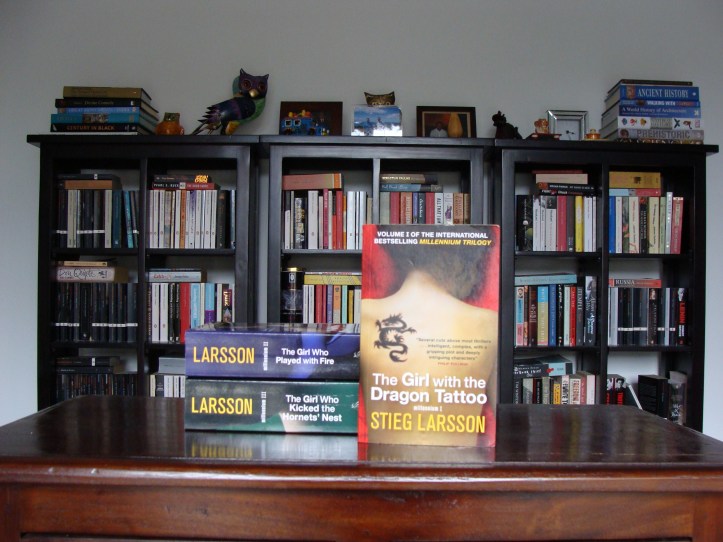Stieg Larsson’s immensely popular Millennium Series offers readers an entertaining diversion but is not without its flaws.
 *This review contains spoilers*
*This review contains spoilers*
In the past I have been very fortunate in choosing books to travel with. Without much thought or planning I have been able to accompany my vacation with a book that gave me what I needed.
You need a large volume that will occupy those many hours spent on planes, trains and buses, in airports and train stations. Something that can be read cover to cover on one plane ride will not suffice.
It needs to be intriguing, entertaining, engaging or stimulating enough that it will keep you turning the pages not matter how tired, jet-lagged, hungry, cold or hot you are. It can’t be too artistic, too trying, too innovative; requiring too many neurons to appreciate and digest.
In the past I have been well-served with Atlas Shrugged, Catch-22 and Shantaram but as I say I was lucky, I did not put too much thought into what to take. On a recent 6 week trip around Northern India, I chose badly. I decided to take two books I had read in the recent past – Rudyard Kipling’s Kim and EM Forster’s A Passage to India. I thought I would gain new appreciation for these books by reading them as I traversed Rajasthan and Himalcha Pradesh, particularly as I would be visiting the town where much of Kim was written (Bundi) and where some of it was set (Shimla).
But these were a poor choice. These are not novels to be read when tired, jet-lagged and crammed into an economy class plane seat or a rural train in India, beset by noise and jolted repeatedly. They demand you be rested, attentive, comfortable and pensive.
Fortunately solutions were easily available. With a large English-speaking population and cheap labour and materials, you can find good books at incredible prices in India. At a bookstore at Connaught Place in New Delhi my wife and I found what we needed. She bought a stack of Agatha Christies for around $3 each. I decided it was time I turned to something I had been avoiding – Steig Larsson’s Millennium Trilogy, which I bought for less than $7 for each book.
The first novel is comfortably the best of the series. The third is equally the weakest.
Perhaps it is my late-Gen-X sensibility, but the minute something achieves mass-popularity, I don’t want to know about it anymore. The huge popularity of the Millennium Trilogy was a turn-off for me and is probably why I have been avoiding it.
But the books are exactly what one requires as a travelling companion – large, engrossing and easy to read.
Those already familiar with the three books will already be aware that calling them a ‘trilogy’ is not entirely accurate. Though all three contain many of the same characters, the first is very much a stand-alone story, while the third book is a continuation of the story that began with the second.
I would have thought that those already familiar with the series will probably share my view that the first novel – The Girl with the Dragon Tattoo – is comfortably the best of the series. However, after a little bit of online scouring, I am surprised to see that many reviewers put all three novels on equal footing, if not placing the latter two even higher. I maintain the first novel is the best crafted, the best thought-through, the least flawed and the best paced – building to a tense and thrilling conclusion.
The second novel – The Girl Who Played with Fire – is certainly more action-packed, more hardcore but perhaps more flawed. But I will come to that later.
The third novel – The Girl Who Kicked the Hornets’ Nest – is the weakest of the three. It essentially just wraps up the story from the second novel. It lacks conciseness as the relatively simple plot is drawn out by, for example, providing back-stories to various new characters. It is page-filling disguised as character development. To Larsson’s credit though, he includes enough plot-turns and keeps enough possible endings open to keep us interested. But the real reason we keep turning pages is because of the strength of the first two novels and our desire to see them satisfactorily concluded.
What annoyed me most in the third novel was the scene in court. There is such a thing as being a bad winner, even in fiction. The gloating came off as sanctimonious and was a turn-off. The personal asides also detracted from any sense of reality in the scene.
Larsson sometimes had to make the characters behave inconsistently or illogically in order for the plot to develop in the direction he needs it to.
All three novels suffer the shortcomings familiar to pop-fiction; the story is heavy on plot and light on the other elements that distinguish literature from pop-fiction. The characterisation is a little formulaic, it feels like it was developed on a spread-sheet or pulled from some dummies guide to writing a best-seller. The plot may have actually been helped by being written on a spread-sheet, if that would have helped iron out the flaws. The style is very matter-of-fact; spelling things out to a reader whose intelligence the writer does not respect. There is no thought to creating setting and mood.
While perusing other reviews I could not help but notice that many fans seem to give the series high regards due to it’s anti-misogynistic themes and celebrate a female protagonist who meets violence with violence as the world of the novels (if not the real world) offers her no alternative she can trust. As noble and notable as these elements may be, they do not excuse the deficiencies of the writing in my mind, nor do they tempt me to elevate the books in my regard.
Perhaps the thing that best exemplifies the difference between my view and theirs is the fact that many seem to wish the English translation of the first novel had retained it’s Swedish title: “Men Who Hate Women”. It is almost as if they wish to celebrate the imperfections of the writing with a title that gave you everything you needed to know about the series’ central tenet. I will reserve my respect for a writer who can respect the reader enough to not spell things out.
Crime is one of the largest, if not the largest, genre of popular fiction today, but admittedly I have not participated in the interest. So I am not sure if the main issue I take with the series is a common failing in the genre or not.
What I mean by this is that there were many times I found the actions of characters did not make sense; either they were not in keeping with the character or there were alternative paths that were more logical. But reading on, you find that these seemingly illogical actions set up what occurs next. In other words, the author sometimes had to make the characters behave inconsistently or illogically in order for the plot to develop in the direction he needs it to. The inconsistencies are plot devices.
These instances were mostly minor and more prevalent in the second and third novels; as I say, the first novel seems to me to be the best crafted and thought-through. Again, I can’t say I have read enough crime fiction to decide if this issue is specific to Larsson or if it is a common obstacle in crime fiction. Works that avoid this issue by being more consistent in character and deed should be considered superior to ones that do not.
Most of these instances did not necessarily detract from the entertainment value of the books, but perhaps the skill of the author goes down in ones estimation. But there were some larger instances in the series.
In Millennium I – surely the first thing Blomkvist would have asked Vanger, when the latter promised him information on Wennerstrom, would have been how old the information was and therefore whether the statute of limitations has lapsed? But Larsson needs a reason for Blomkvist to stay so the question is not asked until the end of the book.
In Millennium II – surely basic forensics (blood spatter, angle of entry, etc) would have quickly established that the shooter was much taller than the diminutive Salander? But Larsson needs Salander to stay on the run and in hiding.
In Millennium III – it seems bizarre that a victim of an attempted murder and the suspected murderer are both given rooms in the same hospital corridor without armed guards. If their conditions were not so severe and the crime scene not so remote, you would not even place them in the same hospital and Salander would have most likely been placed in a police hospital. But Larsson needs it to be so, so that he can make what follows occur.
Lisbeth Salander comes across as a collection of clichés stapled together from a world Larsson does not know much about.
Moving on, there is something that bugs me about Lisbeth Salander. The compliment most often repeated about Larsson’s character is how innovative she is. That bugged me, although admittedly I cannot think of any other character to compare her to in specific terms. So I don’t think my issue is necessarily that Larsson’s creation lacks innovation.
It is not necessarily that I find her hard to believe either. While I am not an expert on the technicalities of her deeds in the novels it would not surprise if they were possible. Nor would it surprise me if there were real Lisbeth Salander’s out there. So it is not that either.
It is more that I do not feel that Larsson made her believable. No one in the novels really knows or understands Salander; not her lovers, not her fellow hackers and certainly not Blomkvist. However, I sensed from the books that Larsson does not really know her either. It was a difficult line for Larsson; he wants Lisbeth to remain mysterious and unpredictable but he failed to make her knowable to the reader; he wants her to be a loner and thus the reader also does not know her world either. Instead her persona comes across as a collection of clichés stapled together from a world Larsson does not know much about.
The Millennium Series served its purpose for me. They offered a light and entertaining jet-lagged read within hotel rooms, airports and planes and I would recommend them to anyone who needs a similar diversion. Now that I’ve read them, the question is where do I place them in my standing? Does their popularity demand they go on the contemporary section of my shelf alongside Attwood, Coetzee and Murakami? Unfortunately no, they will be going in a cardboard box at the bottom of my closet alongside Crichton, Grisham, King and Brown.
The real tragedy though is the untimely death of Larsson that deprived the world of one of it’s most popular writers, whose fans would have hoped for more output from and whose craft they may hoped to see become more refined.

[…] The Millenium Series […]
LikeLike
[…] The Millennium Series by Stieg Larsson [A Review] […]
LikeLike